Ambulatory (Outpatient) Patient Experience and Satisfaction
Surveys are sent to patients after they come to the hospital for ambulatory (outpatient) visits to ask them questions about the care they received during their visit. Patients are asked to answer the questions with "Very Good," "Good," "Fair," "Poor," and "Very Poor." The scores below reflect the percent of time that the patients answered "Very Good." Source of comparison data is Press Ganey National Database Participants.
Access to Care
What are we measuring?
The Access to Care score are the responses to the questions:- Ease of getting clinic on the phone
- Convenience of our office hours
- Ease of scheduling your appointment
- Courtesy of registration staff
What is our most recent performance and trend?
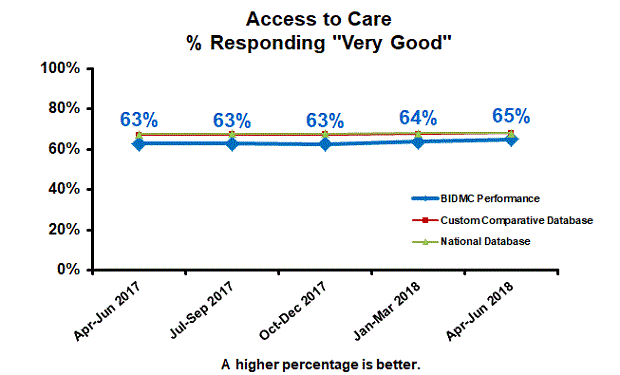
What are we doing to improve?
BIDMC continues to expand its program among ambulatory practices to improve the quality, helpfulness and promptness of telephone and waiting room staff. By engaging a team of "mystery shoppers," we provide prompt feedback to our staff to improve their responsiveness and ability to provide efficient and patient-focused assistance at every interaction. Mystery shopping data has also been used to measure and improve appointment wait times. Participating practices have reduced wait times for new patients by 10 business days since the inception of the program and now routinely offer care within a week.Information about Waits & Delays During Your Visit
What are we measuring?
The Waits and Delays score are the responses to the questions:- Length of wait before going to an exam room
- Information about delays
What is our most recent performance and trend?
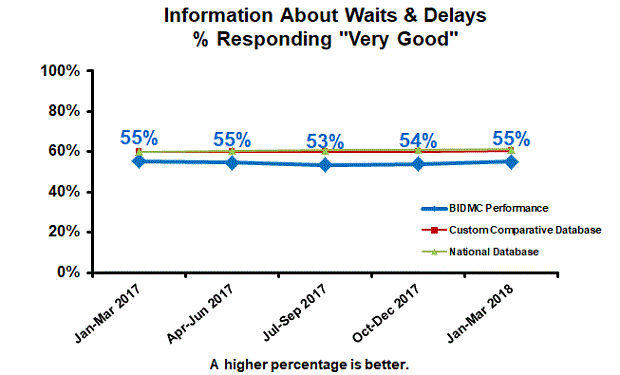
What are we doing to improve?
Many ambulatory practices are piloting methods of informing patients of delays in the waiting room. Some practices, such as OB/GYN and Gastroenterology, update a white board so that patients are informed of any delays at the moment of check-in. Hematology-Oncology assigns a liaison to check in every 20 minutes with those waiting. To reinforce the importance of improving our communication regarding delays, Mystery Shoppers record which departments keep patients informed and share successful methods cross departmentally. We are also assessing causes for unanticipated waits and delays, particularly in the exam rooms. This year, we will initiate a multi-year efficiency project in partnership with our physician leaders. This effort will start with observation, measurement and experimentation with various interventions in a practice where delays are a significant problem. We will take what we learn from this project to spread improvement to other practices.Experience with Care Provider
What are we measuring?
The Experience with Care Provider score are the responses to the questions:- Friendliness/courtesy of the care provider
- Explanations the care provider gave you about your problem or condition
- Concern the care provider showed for your questions or worries
- Care provider's efforts to include you in decisions about your treatment
- Information the care provider gave you about medications
- Instructions the care provider gave you about follow-up care
- Degree to which care provider talked with you using words you could understand
- Amount of time the care provider spent with you
- Your confidence in this care provider
- Likelihood of your recommending this care provider to others
What is our most recent performance and trend?
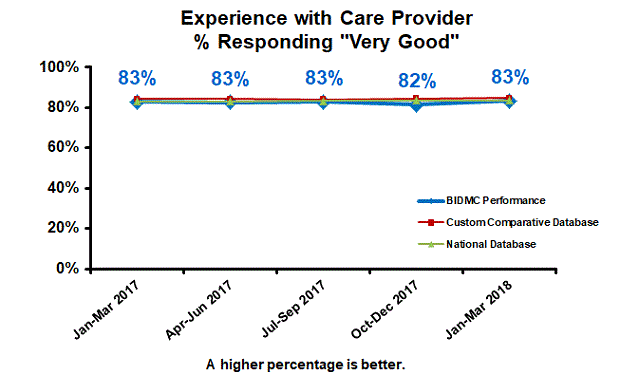
Teamwork Among Staff
What are we measuring?
The Teamwork Among Staff score is the response to the question about how well staff worked together during their outpatient visit.
What is our most recent performance and trend?
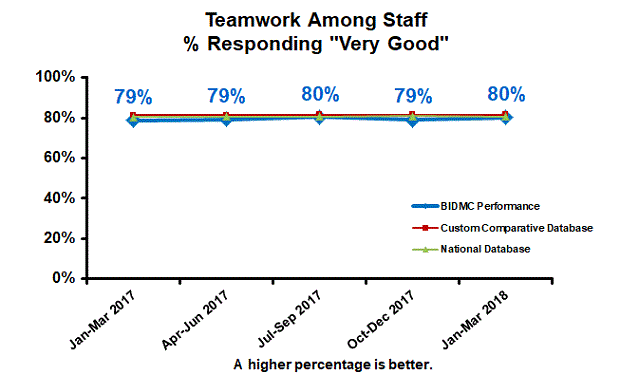
What are we doing to improve?
We launched an initiative across all ambulatory clinics and the Emergency Department. Our "Going from Good to Great" program uses experiential training to help frontline staff view their work from a patient's perspective and ensure consistently attentive, efficient, friendly and respectful service. Clinic staff are empowered to proactively address service needs or issues and identify opportunities to make each patient's visit more personable by being attentive to individual needs, sharing information on delays, providing assistance with directions, listening, and in some clinics, providing refreshments during waits. The "Good to Great" initiative continues with 600+ ambulatory and Emergency Department front line staff participating in annual, ongoing training. The training focuses on employee to employee interactions, both within and across departments. The program is designed to reinforce the fact that all BIDMC employees, no matter what department they are in, are united by a commitment to our patients.Likelihood to Recommend
What are we measuring?
The percent of patients responding "Very Good" to the likelihood of recommending BIDMC to others for ambulatory care.What is our most recent performance and trend?
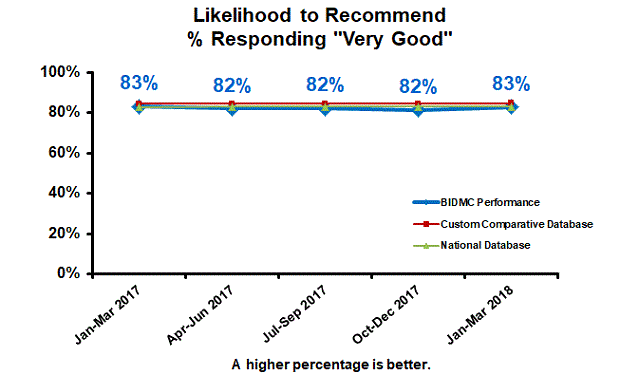
Other Measures of Patient Experience:
Last updated: May 2018
